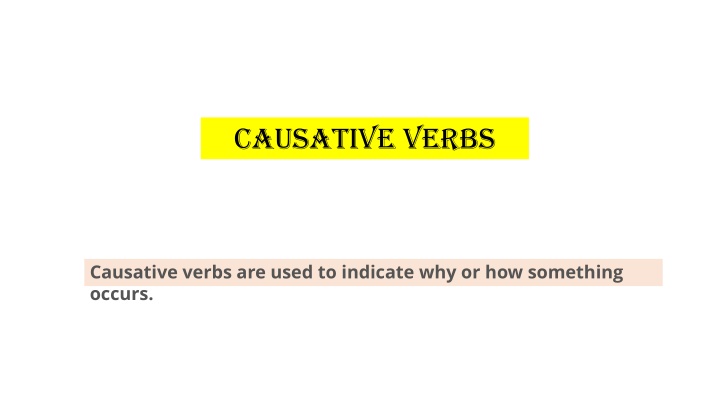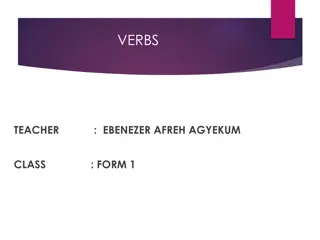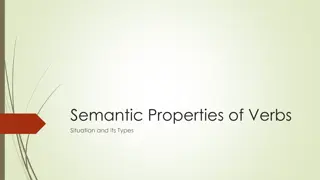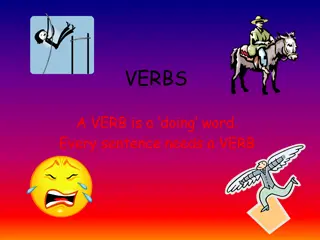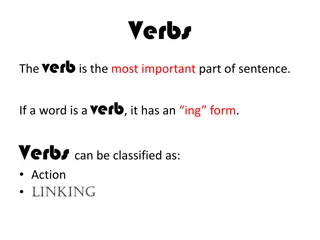Causative Verbs: Let, Permit, Make, and More
Causative verbs are essential in indicating how or why something happens by showing that the subject gets someone or something else to do an action for them. This guide explores common causative verbs like let, permit, make, force, require, and more, providing examples and explanations for each. Learn how to correctly use these verbs to convey causation in sentences.
Download Presentation

Please find below an Image/Link to download the presentation.
The content on the website is provided AS IS for your information and personal use only. It may not be sold, licensed, or shared on other websites without obtaining consent from the author.If you encounter any issues during the download, it is possible that the publisher has removed the file from their server.
You are allowed to download the files provided on this website for personal or commercial use, subject to the condition that they are used lawfully. All files are the property of their respective owners.
The content on the website is provided AS IS for your information and personal use only. It may not be sold, licensed, or shared on other websites without obtaining consent from the author.
E N D
Presentation Transcript
Causative verbs Causative verbs are used to indicate why or how something occurs.
Definition of Causative Verbs Causative verbs are verbs that show the reason that something happened. They do not indicate something the subject did for themselves, but something the subject got someone or something else to do for them. The causative verbs are: let (allow, permit), make (force, require), have, get, and help.
Let, Allow and Permit Let, Allow and Permit The causative verb let is used to express that we ve given someone permission to do something.Sentences using the causative verb let generally follow this pattern: Let + Person/thing + Base form of verb The base form of a verb, also simply called a base verb, is the basic, plain version of a verb that you would find in the dictionary, such as play, jump, run, sing, drive, and kick. Mom let my brother drive the car. In this sentence we see the causative verb let. Let is followed by a person/thing (in this case, my brother). The person/thing (my brother) is then followed by a base verb, drive. Therefore, this sentence follows the pattern Let + Person/thing + Base form of verb, correctly using the causative verb let.
Two less common causative verbs, permit and allow are synonyms of let. These two causative verbs follow a similar pattern: Permit or Allow + Person/thing + Infinitive form of verb The infinitive form of a verb, also called an infinitive, is just the base verb with the word to in front of it, such as to play, to jump, to run, to sing, to drive, and to kick. Example: My school does not permit the students to wear flip flops. This sentence uses the causative verb permit. Permit is followed by a person/thing (the students). After the person/thing (the students), this sentence includes the infinitive to wear. This means that the sentence correctly uses the causative verb It follows the pattern Permit + person/thing + infinitive. This sentence would be the same if we used the verb allow instead of permit, as in, My school does not allow the students to wear flip flops.
Make, Force and Require Make, Force and Require The causative verb make is used to express that someone has forced someone else to do something. With make, we use the following pattern: Make + person + base verb My mom made me clean my room before the party. This example uses made, form of the causative verb make. Made is followed by a person (me). This person (me) is followed by the base verb clean. This sentence correctly follows the pattern Make + person + base verb. This is the proper way to use the causative verb make .
Force and require are two less common causative verbs that have the same meaning as make. They follow a similar pattern: Force or Require + person + infinitive The law requires everyone to wear a seatbelt in the car. In this sentence, we see a form of the causative verb require. Requires is followed by a person (everyone). After the person (everyone), the sentence includes the infinitive to wear. This is how to correctly use the causative verb require : Force or Require + person + infinitive. This sentence would be the same if we replaced the verb requires with the verb forces as in, The law forces everyone to wear a seatbelt in the car.
have have The causative verb have is used to explain that we re going to get someone else to do something. There are two different patterns we can use with the causative verb have. The first pattern is: Have + person + base verb I ll have my mom call your mom and ask if you can come over. This sentence uses the causative verb have. After have, the sentence mentions a person (my mom). My mom is followed by the base verb call. This sentence correctly uses the pattern for the causative verb have : Have + person + base verb.
A past participle is the base verb with an ed ending, such as played, jumped, painted, watched, or cried. (NOTE: This is only true for regular verbs, which follow a regular pattern. Irregular verbs don t follow this pattern and have different endings: drove, ran, sang, etc.) Example: I need to have my car washed. This example uses the causative verb have. Have is followed by a thing (my car). After my car, the sentence also uses a past participle (washed). This sentence also correctly uses the causative verb have, following the pattern Have + thing + past participle of verb. Both patterns for the causative verb have explain that you re going to get someone else to do something. However, the first pattern is used when you re explaining exactly who is going to do the action. The second pattern is used when you aren t sure who s going to do the action.
Get Get We use the causative verb get to describe convincing or encouraging someone to do something. It follows this pattern: Get + person + infinitive How can I get my sister to do my chores? This sentence uses the causative verb Get is followed by a person (my sister). This person (my sister) is followed by the infinitive to do. This sentence correctly uses the causative verb get by following the pattern Get + person + infinitive.
help The causative verb help is used when someone assists someone else in completing a task. There are two correct patterns for the causative verb help. You can use either one of the following: Help + person + base verb Help + person + infinitive Although both of these patterns are correct, the first one (the base verb instead of the infinitive) is more common.
My mom helps me complete my homework. My mom helps me to complete my homework. In this example, we see the causative verb help. Help is followed by a person (me). The person (me) is followed by the base verb complete. This sentence demonstrates one way to correctly use the causative verb help : Help + person + base verb This example also uses the causative verb help. Help is followed by a person (me) again. This time, the person (me) is followed by the infinitive to complete. This sentence demonstrates the second way to correctly use the causative verb help: Help + person + infinitive. Both of these sentences are grammatically correct, but most people would agree that the first version of the sentence sounds more natural. Remember that causative verbs are used to explain that someone or something causes an action to happen. You can use any form of the verb, but you do need to organize your sentences correctly.
RULES: Teacher will pick one student. Then that student has to pick another student. Teacher will show a task card and the rest is surprise
Would your friend prefer to deal with viruses on his/her own or have a technician take a look at the computer?
How comfortable is your friend with household repairs himself/herself vs. hiring a stranger to do it for himself /herself ?
Would your friend prefer to groom his/her pet himself/herself or have a groomer have it?
How comfortable is your friend with having a maid clean up after him/her ?
If your friends depended on passing an exam, how likely is your friend to have someone else to take it for himself/herself?
Would your friend prefer to deal with an ingrown toenail on his/her own or have a doctor deal with it?
How likely is your friend to have someone else to come to his/her house to deal with a spider infestation vs. dealing with it himself/herself?
